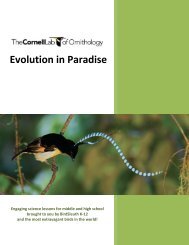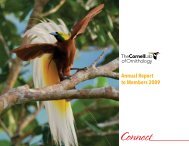ForewordWhen I was growing up, it was takenas a matter <strong>of</strong> faith that kids belongedoutside. I grew up with 4 brothers, <strong>and</strong>during those long, hot Atlanta summers,it was common for our mom to holler,“You boys get outside, <strong>and</strong> don’t comeback ‘til it’s dark.” It never occurredto me or my brothers to do anythingelse in our spare time but explore theworld around us. The truth is, we hadlittle else to do. But those experiences– waking up on frosty mornings <strong>and</strong>starting the campfire, scanning treesfor a shot at a scampering gray squirrelin the dawn light, scouring creek bedsfor crawdads <strong>and</strong> other fishing bait,or simply <strong>of</strong> the fun we had trampingthrough the forest – shaped who I am,<strong>and</strong> drew me to a career in conservation.That’s why I’m excited by this 2011<strong>National</strong> <strong>Survey</strong> <strong>of</strong> <strong>Fishing</strong>, <strong>Hunting</strong>,<strong>and</strong> <strong>Wildlife</strong>-Associated Recreation.This report, the 12th in a series thatbegan in 1955, documents a significantresurgence in the number <strong>of</strong> peopleembracing America’s Great Outdoors.<strong>Hunting</strong> participation has increased by9 percent, while angling participationgrew by 11 percent. Nearly 38 percent<strong>of</strong> Americans participated in wildliferelatedrecreation, an increase <strong>of</strong> 2.6million participants from the 2006<strong>Survey</strong>.In addition, wildlife-related recreationis a major driver <strong>of</strong> the nation’seconomy. The 2011 <strong>Survey</strong> estimatesthat Americans spent $145 billion onrelated gear, trips, licenses, l<strong>and</strong> acquisitionor leases, <strong>and</strong> other purchases,representing about one percent <strong>of</strong> thenation’s gross domestic product. Thisspending creates thous<strong>and</strong>s <strong>of</strong> jobs,supports countless local communities<strong>and</strong> provides vital funding for conservation.This year marks the 75th anniversary<strong>of</strong> the <strong>Wildlife</strong> <strong>and</strong> Sport Fish RestorationProgram, a cornerstone <strong>of</strong> wildlifeconservation in the United States.Through excise taxes on firearms,ammunition, archery <strong>and</strong> anglingequipment, the U.S. Fish <strong>and</strong> <strong>Wildlife</strong>Service has distributed over $14 billionfor State <strong>and</strong> territorial wildlife conservationprograms.This report would not have beenpossible without the combined efforts<strong>of</strong> state wildlife agencies – whichprovided financial support throughthe Multi-State Conservation GrantPrograms – the Association <strong>of</strong> Fish<strong>and</strong> <strong>Wildlife</strong> Agencies <strong>and</strong> a number <strong>of</strong>major national conservation organizations.We also owe our gratitude to thethous<strong>and</strong>s <strong>of</strong> survey respondents fromhouseholds across America. Because<strong>of</strong> you, this <strong>Survey</strong> is the nation’sdefinitive wildlife-related recreationdatabase <strong>and</strong> information sourceconcerning participation <strong>and</strong> purchasesassociated with hunting, fishing <strong>and</strong>other forms <strong>of</strong> wildlife-associatedrecreation nationwide.The Fish <strong>and</strong> <strong>Wildlife</strong> Service is dedicatedto connecting people <strong>and</strong> familieswith nature. We are proud to celebratethe good news in this report, <strong>and</strong> welook forward to continuing progressas we work with the States, <strong>and</strong> allour partners <strong>and</strong> the public to helpkeep recreational fishing, hunting, <strong>and</strong>wildlife watching growing <strong>and</strong> goingstrong.Dan AsheDirector, U.S. Fish <strong>and</strong> <strong>Wildlife</strong> Servicevi 2011 <strong>National</strong> <strong>Survey</strong> <strong>of</strong> <strong>Fishing</strong>, <strong>Hunting</strong>, <strong>and</strong> <strong>Wildlife</strong>-Associated Recreation U.S. Fish <strong>and</strong> <strong>Wildlife</strong> Service <strong>and</strong> U.S. Census Bureau
<strong>Survey</strong> Background <strong>and</strong> MethodThe <strong>National</strong> <strong>Survey</strong> <strong>of</strong> <strong>Fishing</strong>,<strong>Hunting</strong>, <strong>and</strong> <strong>Wildlife</strong>-AssociatedRecreation (<strong>Survey</strong>) has beenconducted since 1955 <strong>and</strong> is one <strong>of</strong>the oldest <strong>and</strong> most comprehensivecontinuing recreation surveys. The<strong>Survey</strong> collects information on thenumber <strong>of</strong> anglers, hunters, <strong>and</strong> wildlifewatchers, how <strong>of</strong>ten they participate,<strong>and</strong> how much they spend on theiractivities in the United States.Preparations for the 2011 <strong>Survey</strong>began in 2008 when the Association <strong>of</strong>Fish <strong>and</strong> <strong>Wildlife</strong> Agencies (AFWA)asked the Fish <strong>and</strong> <strong>Wildlife</strong> Service tocoordinate the twelfth <strong>National</strong> <strong>Survey</strong><strong>of</strong> wildlife-related recreation. Fundingcame from the Multistate ConservationGrant Programs, authorized by <strong>Wildlife</strong><strong>and</strong> Sport Fish Restoration Acts, asamended.Four regional technical committeeswere set up under the auspices <strong>of</strong>AFWA to ensure that State fish <strong>and</strong>wildlife agencies had an opportunity toparticipate in all phases <strong>of</strong> survey planning<strong>and</strong> design. The committees weremade up <strong>of</strong> agency representatives.We consulted with State <strong>and</strong> Federalagencies <strong>and</strong> nongovernmentalorganizations such as the AmericanSportfishing Association <strong>and</strong> <strong>National</strong>Shooting Sports Foundation to determinesurvey content. Other sportspersons’organizations <strong>and</strong> conservationgroups, industry representatives, <strong>and</strong>researchers also provided valuableadvice.Data collection for the <strong>Survey</strong> wascarried out in two phases by theU.S. Census Bureau. The first phasewas the screen which began in April2011. During the screening phase, theCensus Bureau interviewed a sample<strong>of</strong> 48,600 households nationwide, todetermine who in the household hadfished, hunted, or wildlife watched in2010, <strong>and</strong> who had engaged or plannedto engage in those activities in 2011.In most cases, one adult householdmember provided information for allmembers. The screen primarily covered2010 activities while the next, morein-depth phase covered 2011 activities.For more information on the 2010 data,refer to Appendix B.The second phase <strong>of</strong> data collectionconsisted <strong>of</strong> three detailed interviewwaves. The first wave began in April2011 concurrent with the screen, thesecond in September 2011, <strong>and</strong> thelast in January 2012. Interviews wereconducted with samples <strong>of</strong> likelyanglers, hunters, <strong>and</strong> wildlife watcherswho were identified in the initialscreening phase. Interviews wereconducted primarily by telephone, within-person interviews for respondentswho could not be reached by phone.Respondents in the second surveyphase were limited to those who wereat least 16 years old. Each respondentprovided information pertaining onlyto his or her activities <strong>and</strong> expenditures.Sample sizes were designed toprovide statistically reliable results atthe state level. Altogether, interviewswere completed for 11,330 anglers <strong>and</strong>hunters <strong>and</strong> 9,329 wildlife watchers.More detailed information on samplingprocedures <strong>and</strong> response rates is foundin Appendix D.Comparability WithPrevious <strong>Survey</strong>sThe 2011 <strong>Survey</strong>’s questions <strong>and</strong>methodology were similar to thoseused in the 2006, 2001, 1996, <strong>and</strong> 1991<strong>Survey</strong>s. Therefore, the estimates arecomparable.The methodology for these <strong>Survey</strong>sdiffers significantly from the 1955to 1985 <strong>Survey</strong>s, so these estimatesare not directly comparable to those<strong>of</strong> earlier surveys. Changes in methodologyincluded reducing the recallperiod over which respondents had toreport their activities <strong>and</strong> expenditures.Previous <strong>Survey</strong>s used a 12-monthrecall period which resulted in greaterreporting bias. Research found that theamount <strong>of</strong> activity <strong>and</strong> expendituresreported in 12-month recall surveyswas overestimated in comparisonwith that reported using shorter recallperiods.U.S. Fish <strong>and</strong> <strong>Wildlife</strong> Service <strong>and</strong> U.S. Census Bureau2011 <strong>National</strong> <strong>Survey</strong> <strong>of</strong> <strong>Fishing</strong>, <strong>Hunting</strong>, <strong>and</strong> <strong>Wildlife</strong>-Associated Recreation vii
- Page 1: U.S. Fish & Wildlife Service2011Nat
- Page 4 and 5: Economics and StatisticsAdministrat
- Page 6 and 7: List of TablesFishing and Hunting1.
- Page 11 and 12: Highlights
- Page 13 and 14: watching (observing, photographing,
- Page 15 and 16: Expenditures for Wildlife-Related R
- Page 17 and 18: Fishing
- Page 19 and 20: Fishing ExpendituresAnglers spent $
- Page 21 and 22: Freshwater Fishing ExpendituresAngl
- Page 23 and 24: pike, pickerel, and muskie, as well
- Page 25 and 26: Sex and Age of AnglersAlthough more
- Page 27 and 28: The majority of anglers had househo
- Page 29: 2001-2011 Fishing Participants, Day
- Page 32 and 33: Hunting HighlightsIn 2011, 13.7 mil
- Page 34 and 35: Big Game HuntingIn 2011, a majority
- Page 36 and 37: Days per hunterTrips per hunterTrip
- Page 38 and 39: Hunting on Public and PrivateLandsm
- Page 40 and 41: Large MSA25%Medium MSA17%Percent of
- Page 42 and 43: Hispanics, who represent a growingp
- Page 45 and 46: Wildlife WatchingU.S. Fish and Wild
- Page 47 and 48: Wildlife-Watching ExpendituresThirt
- Page 49 and 50: Wildlife Fed, Observed, orPhotograp
- Page 51 and 52: Metropolitan and NonmetropolitanAro
- Page 53 and 54: Education, Race, and Ethnicity ofAr
- Page 55 and 56: Away-From-Home Participantsby Type
- Page 57 and 58: Away-From-Home WildlifeWatchers by
- Page 59 and 60:
Metropolitan and NonmetropolitanAwa
- Page 61 and 62:
2001-2011 Comparison of Wildlife-Wa
- Page 63:
2006-2011 Wildlife-Watching Partici
- Page 66 and 67:
Guide to Statistical TablesPurpose
- Page 68 and 69:
Table 3. Freshwater Anglers and Day
- Page 70 and 71:
Table 7. Hunters and Days of Huntin
- Page 72 and 73:
Table 8. Selected Characteristics o
- Page 74 and 75:
Table 9. Selected Characteristics o
- Page 76 and 77:
Table 10. Selected Characteristics
- Page 78 and 79:
Table 12. Expenditures for Fishing:
- Page 80 and 81:
Table 14. Trip and Equipment Expend
- Page 82 and 83:
Table 16. Trip and Equipment Expend
- Page 84 and 85:
Table 18. Trip and Equipment Expend
- Page 86 and 87:
Table 20. Trip and Equipment Expend
- Page 88 and 89:
Table 22. Special Equipment Expendi
- Page 90 and 91:
Table 25. Freshwater Anglers and Da
- Page 92 and 93:
Table 29. Hunters and Days of Hunti
- Page 94 and 95:
Table 33. Hunters Preparing for Hun
- Page 96 and 97:
Table 37. Participation in Wildlife
- Page 98 and 99:
Table 40. Expenditures for Wildlife
- Page 100 and 101:
Table 41. Selected Characteristics
- Page 102 and 103:
Table 42. Selected Characteristics
- Page 104 and 105:
Table 46. Total Wildlife-Related Pa
- Page 106 and 107:
Appendix A.DefinitionsAnnual househ
- Page 108 and 109:
State governments (such as State pa
- Page 110 and 111:
Appendix B.2010 Participation of 6-
- Page 112 and 113:
Table B-4. Most Recent Year of Fish
- Page 114 and 115:
Table B-7. Selected Characteristics
- Page 116 and 117:
Table B-9. Participation by 6-to-15
- Page 118 and 119:
Appendix C.Significant Methodologic
- Page 120 and 121:
Table C-1. Major Characteristics of
- Page 122 and 123:
Table C-2. Anglers and Hunters by C
- Page 124 and 125:
household income in the 2001Survey.
- Page 126 and 127:
Table C-4. Comparison of Major Find
- Page 128 and 129:
Table C-5. Anglers and Hunters by C
- Page 130 and 131:
Appendix D.Sample Design and Statis
- Page 132 and 133:
lation 6 to 15 years of age were de
- Page 134 and 135:
compute in advance the standard err
- Page 136 and 137:
Illustration of the Computation of
- Page 138 and 139:
Table D-2. Approximate Standard Err
- Page 140 and 141:
Table D-4. Approximate Standard Err
- Page 143:
U.S. Department of the InteriorU.S.






